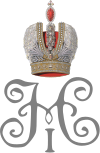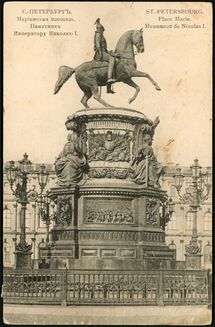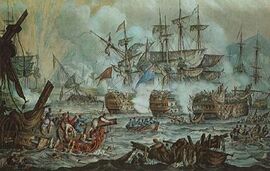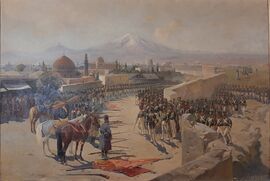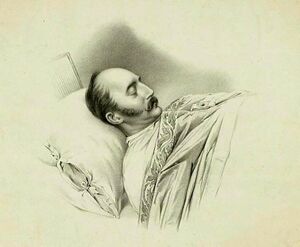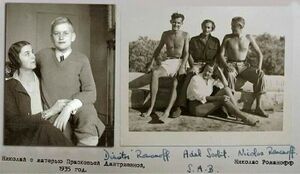نيقولاي الأول من روسيا
| نيقولاي الأول Nicholas I | |
|---|---|
| إمبراطور وأوتوقراط كل الروسيات ملك پولندا؛ الدوق الأعظم لفنلندا | |
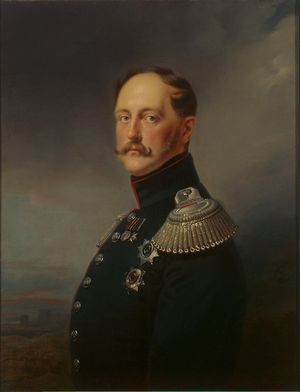 | |
| العهد | 1 ديسمبر 1825–2 مارس 1855 |
| التتويج | 3 سبتمبر 1826 |
| سبقه | ألكسندر الأول |
| تبعه | ألكسندر الثاني |
| الدفن | |
| الزوج | شارلوت من پروسيا |
| الأنجال | ألكسندر الثاني من روسيا ماريا، دوقة لوختنبرگ أولگا، ملكة ڤورتمبرگ ألكسندرا، أميرة فردريك ڤيليام من هسه-كاسه الدوق الأعظم نيقولا نيقولايڤيتش الدوق الأعظم نيقولاي الدوق الأعظم ميخائيل |
| البيت | أسرة هولشتاين-گوتورپ-رومانوڤ |
| الأب | پاڤل من روسيا |
| الأم | صوفيا دورثيا من ڤورتمبرگ |
| الديانة | الأرثوذكسية الروسية |
| التوقيع | |
نيقولاي الأول (روسية: Николай I Павлович، Nikolaj I Pavlovič[pron 1] و. 6 يوليو [ن.ق. 25 يونيو] 1796 -2 مارس [ن.ق. 18 فبراير] 1855)، كان قيصر روسيا وملك پولندا والدوق الأعظم لفنلندا. وهو ثالث أبناء پاڤل الأول، والشقيق الأصغر لسلفه ألكسندر الأول. بدأ حكم نيقولاي الأول بفشل ثورة الديسمبريين. يُذكر في التاريخ بشكل رئيسي بأنه رجعياً، اتسم عهده المثير للجدل بالتوسع الجغرافي، ومركزية السياسات الإدارية، وقمع المعارضة. تمتع نيقولاي بزواج سعيد أنجب منه عائلة كبيرة؛ حيث عاش جميع أبنائه السبعة.[1]
قال كاتب سيرته نيقولاي رياسانوڤسكي أنه أظهر تصميماً، وثباتاً على الهدف، وإرادةً صلبة، إلى جانب شعور قوي بالواجب وتفاني في العمل الجاد. كان يرى نفسه جنديًاً-ضابطاً شاباً غارقاً في اللعاب والتهذيب. كان رجلاً وسيماً، لكنه كان شديد العصبية والعدوان. تدرب كمهندس عسكري، وكان شديد الحرص على أدق التفاصيل. وفي شخصيته العامة، كما ذكر رياسانوڤسكي، "أصبح نيقولاي الأول يُجسد الاستبداد: مهيباً بلا حدود، حازماً وقوياً، صلباً كالصخر، وعنيداً كالقدر".[2]
كان لنيكولاي الأول دور أساسي في المساعدة على إقامة دولة يونانية مستقلة، ولخص الفتح الروسي للقوقاز بالاستيلاء على محافظة إغدير وما تبقى من أرمينيا وأذربيجان الحاليتين من فارس القاجارية أثناء الحرب الروسية الفارسية 1826-1828. كما أنهى الحرب الروسية التركية 1928-1929. لكنه قاد روسيا لاحقاً إلى حرب القرم (1853-1856)، وكانت نتائجها كارثية. يؤكد المؤرخون أن إدارته التفصيلية للجيوش أعاقت جنرالاته، وكذلك استراتيجيته الخاطئة. ويشير وليام فولر إلى أن المؤرخين خلصوا مراراً إلى أن "عهد نيقلاوي الأول كان فشلاً ذريعاً في السياسة الداخلية والخارجية".[3] في عشية وفاته، وصلت الإمبراطورية الروسية إلى ذروتها اتساعها، حيث امتدت على مساحة تزيد عن 20 مليون كم²، لكنها كانت في حاجة ماسة إلى الإصلاح.
حياته وتوليه العرش
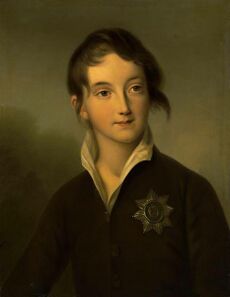
وُلد نيقولاي في جاتشينا وكان ابناً للقيصر پاڤل الأول. وفي ديسمبر 1825، وبعد أن أصبح نيقولاي قيصراً، حاولت مجموعة من النبلاء ذوي الميول الإصلاحية الاستيلاء على السلطة. وأمه هي الامبراطورة ماريا ڤيودوروڤنا. تلقى نيقولاي پاڤلوڤيتش رومانوڤ التعليم الجيد على أيدي خيرة المدرسين في القصر الشتوي. لكنه لم يظهر التفاني في دراسة العلوم. ويخص هذا الأمر قبل كل شيء العلوم الإنسانية. لكنه اهتم كثيراً بالفنو الحربية والهندسة. ويشير المؤرخون إلى ولع نيقولاي في أيام الطفولة والشباب بالفنون التشكيلية وتلقيه الدروس في هذا المجال على يد الرسام الروسي آكيموڤ.
أبلغ الامبراطور ألكسندر الأول نيقولاي عام 1819 رغبة ولي العهد قسطنطين في التنازل عن العرش القيصري. كما أبلغه بأنه سيتوجب عليه تولي واجبات ولي العهد بصفته الأخ الأكبر لقسطنطين، علماً بأن قسطنطين تزوج من أميرة پولندية وليس لديه أطفال. وقد تنازل قسطنطين عن العرش بشكل غير رسمي عام 1823. لكن وفاة ألكسندر المفاجأة في 17 نوفمبر 1824 كشفت عن الوضع المعقد في أسرة رومانوڤ. وأعد ألكسندر بيان وراثة يقضي بتعيين ولي العهد الجديد عام 1823 وأمر بأن يحفظ البيان في كاتدرائية أوسبينسكي بموسكو ولا يتم اشهاره إلا بعد موته.
بعد الإطلاع على محتويات البيان امتنع نيقولاي عن اعلان نفسه امبراطوراً ما لم يتخل قسطنطين رسمياً عن العرش، الأمر الذي أدى إلى أن رعايا الامبراطورية أدوا القسم لقسطنطين. كما أن نيقولاي نفسه أدى القسم له. لكن قسطنطين بصفته امبراطوراً جديداً رفض تولي الحكم القيصري. وظل هذا الوضع مستمراً فترة 25 يوماً وتسبب في قيام ثورة ديسمبر التي دبرها كبار الضباط في الجيش والمثقفون في روسيا. ذوي الميول الإصلاحية، بتشجيع من اليهود، من أجل الاستيلاء على السلطة، كل هذه العوامل مجتمعة أجبرته على تولي العرش في 14 ديسمبر 1825، ليصبح قيصراً على روسيا في الفترة ما بين 1825- 1855.
في نهاية المطاف أعلن نيقولاي نفسه امبراطوراً وعين موعد مراسم أداء القسم الجديد في 14 ديسمبر 1825، الأمر الذي استغله المتمردون. وقد استهلّ عمله بالقضاء على الثورة، وإعدام خمسة من قادتها، ونفي الآخرين إلى سيبريا، أو إيداعهم السجن.
السياسة الداخلية
ألغى القيصر نيقولاي عدة مناطق من الحكم الذاتي المحلي. أُلغي استقلال بسارابيا عام 1828، واستقلال پولندا عام 1830، واستقلال القهل اليهودي عام 1843. واستثناءً من هذا التوجه، استطاعت فنلندا الحفاظ على استقلالها، ويعود ذلك جزئياً إلى مشاركة الجنود الفنلنديين المخلصين في سحق انتفاضة نوفمبر في پولندا.[4]
أًُفتتح أول خط سكة حديد في روسيا عام 1837، بطول 26 كم بين سانت پطرسبرگ وضاحية تسارسكويه سيلو. أما الخط الثاني فكان سكك حديد سانت پطرسبرگ-موسكو، الذي بُني بين عامي 1842 و1851. ومع ذلك، بحلول عام 1855، لم يتجاوز طول السكك الحديدية الروسية 920 كم.[5]
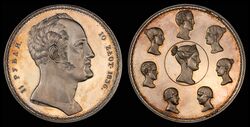
كبر نقولاي الأول الجيش حتى استهلك نحو 40% من الموازنة، وأقام نظام الثكنات والتدريب العسكري، وأعطى عدداً قليلاً من معاونيه سلطات واسعة، وحاول إدارة روسيا كما لو كانت وحدة عسكرية. وعلى الرغم من أنّ حرية الفكر كانت منتشرة واسعاً، فقد عمل منذ عام 1826م على تأسيس «الفرع الثالث» الخاص بمكتب القيصر من أجل القضاء على الحركة الثورية، والمعارضة الجماهيرية، وملاحقة الأفكار التقدمية المتزايدة للمثقفين. وأنشأ شرطة سريّة لمنع أي نشاط معادٍ للحكومة. وعزّز الجهاز العسكري البيروقراطي، وركّز السلطات في يده، ووضع الصحف تحت الرقابة، واضطهد الكتّاب الروس، وسيطر على الجامعات، وطالب الجميع بالولاء للقيصر والكنيسة الأرثوذوكسية الشرقية والأمة الروسية. فعرف بحكمه القاسي، وتميّز عهده بالتنكيل الدموي للحركات المطالبة بالحرية، وحركات الاستقلال في المناطق البعيدة، ومطاردة اليهود، فكانت ضحايا حكمه الاستبدادي كثيرة، وحَكَمَ على كثير منهم بالنفي والأعمال الشاقة. وفي عهده تفاقمت أزمة نظام الرق الإقطاعي؛ لكنه بالمقابل أدخل العديد من الإصلاحات والتنظيمات الاجتماعية والاقتصادية. ففي عهده صدرت أوّل مجموعة قانونية روسية حديثة عام 1835م، وتمّت الموافقة على تحسين مستوى حياة الفلاحين العاملين في أراضي الدولة، مع الإشارة إلى واجباتهم، وعمل على إصلاح إدارة الدولة، ومع أنه كان حريصاً على عدم مسِّ مصالح طبقة النبلاء (الأشراف) بأذى، لا بل كان اتجاهه الأساسي في إدارة الحكم هو حرصه على ترسيخ دولة النبلاء الإقطاعيين، فإن تطور النظام الرأسمالي وضغط البرجوازية الناشئة، دفعته إلى التساهل والنزول عن كثير لمصلحة طبقة الصنّاع والتجّار (البرجوازية)، ففي سنة 1828م أنشأ مجلس مصانع النسيج، وافتتح معهداً تقنياً لتجهيز فنيين مختصين، نظموا فيما بعد معارض صناعية، ووافق على بناء سكة حديد روسيا.
كانت أولى الخطوات التي اتخذها الامبراطور الجديد هي اعادة الشاعر پوشكين من المنفى. وتعيين الشاعر ڤاسيلي جوكوڤسكي الذي اتصف بافكاره الليبرالية مشرفا على تربية ولي العهد الكسندر (الامبراطور الكسندر الثاني فيما بعد).
كان من اهم اتجاهات سياسة نيقولاي الداخلية تعزيز أركان السلطة وجعلها مركزية. ولهذا الغرض تم تأسيس دائرة سرية اطلق عليها اسم الشعبة الثالثة ترأسها الجنرال بيكيندورف الذي تحول لاحقا الى ما يشبه رمز عهد نيقولاي الأول. وقد أوقف نيقولاي ثورة الديسمبريين هذه كما كانوا يسمونها، وأعدم خمسة من قادتها ونفى الآخرين إلى سيبريا أو أودعهم السجن.
وكان نقولا ضابطًا بالجيش، وحاول إدارة روسيا كما لو كانت وحدة عسكرية. فأعطى عددًا قليلاً من معاونيه سلطات واسعة، وأنشأ شرطة سرية لمنع أي نشاط معاد للحكومة. كما وضع الصحف تحت الرقابة، واضطهد الكتاب الروس، وسيطر على الجامعات. وطالب الكل بالولاء للقيصر والكنيسة الأرثوذكسية الشرقية والأمة الروسية.
وفي عامي 1830 و1831، سحق نقولا بقسوة بالغة ثورة في بولندا وكانت بولندا عندئذ جزءًا من الإمبراطورية الروسية الواسعة. وألغى الحكم الذاتي البولندي وتقسيم البلاد الى محافظات.
وفي 1835، شكل نيقولاي الثاني لجنة كلفها باعداد قوانين ترمي الى تحسين وضع الفلاحين الأقنان في روسيا. وقد صدرت القوانين التي منعت النبلاء من بيع الفلاحين بمفردهم ودون عقارات. كما منح الفلاحون الحق بنيل الحرية في حال بيع عزب اصحابهم. وقد شكلت تلك القوانين قاعدة لالغاء نظام القنانة في روسيا الذي حققه ابنه الكسندر.
ويعود الى نيقولاي فضل بناء أول سكك حديدية في روسيا. ويقال أن الامبراطور كان أول من ركب قطار صممه المهندس ستيفنسون وطلب منه ان يجعل عرض السكة أكبر بالمقارنة مع السكة الاوروبية.
ملك پولندا
تُوِّج نيقولاي ملكاً لپولندا في وارسو في 12 (24) مايو 1829، وفقاً للدستور الپولندي، وهي وثيقة لم يلتزم بها بعد ذلك. وهو الملك الروسي الوحيد الذي تُوِّج ملكاً لپولندا[6]— على الرغم من أنه ليس الوحيد الذي مُنح هذا اللقب.
الثقافة
أثار التركيز الرسمي على القومية الروسية جدلاً حول مكانة روسيا في العالم، ومعنى تاريخها، ومستقبلها. اعتقدت مجموعة، وهي الغربية، أن روسيا لا تزال متخلفة وبدائية، ولا يمكنها التقدم إلا من خلال المزيد من التوجه الأوروپي. بينما أيدت مجموعة أخرى، وهي السلاڤونية، المتحمسة للسلاڤ وثقافتهم وعاداتهم، وكان لديها نفور من الغربيين وثقافتهم وعاداتهم.
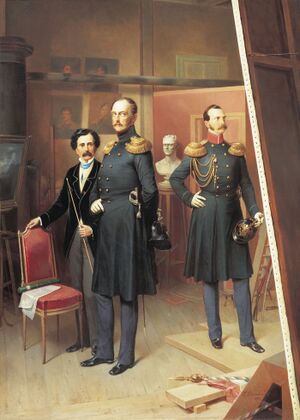
اعتبر السلاڤ الفلسفة السلاڤية مصدراً للتكامل في روسيا، وكانوا متشككين في العقلانية والمادية الغربية. اعتقد بعضهم أن الكوميونة الفلاحية الروسية، أو المير، تُقدم بديلاً جذاباً للرأسمالية الغربية، ويمكن أن تجعل من روسيا منقذاً اجتماعياً وأخلاقياً محتملاً، مما يُمثل شكلاً من أشكال المسيحانية الروسية. مع ذلك، انتهجت وزارة التعليم سياسة إغلاق كليات الفلسفة بسبب الآثار الضارة المحتملة.[7]
في أعقاب ثورة الديسمبريين، سعى القيصر إلى حماية الوضع الراهن من خلال مركزية النظام التعليمي. أراد تحييد خطر الأفكار الأجنبية وما سخر منه باعتباره "المعرفة الزائفة". ومع ذلك، عزز وزير تعليمه، سرگي أوڤاروف، بهدوء الحرية والاستقلالية الأكاديمية، ورفع المعايير الأكاديمية، وحسّن المرافق، وفتح التعليم العالي أمام الطبقة المتوسطة. وبحلول عام 1848، خشي القيصر أن تُلهم الاضطرابات السياسية في الغرب انتفاضات مماثلة في روسيا، فوضع حداً لابتكارات أوڤاروف.[8]
كانت الجامعات صغيرة وخاضعة للرقابة الدقيقة، وخاصةً أقسام الفلسفة التي كانت تُشكل خطراً محتملاً. كانت مهمتها الرئيسية تدريبَ قياداتٍ إداريةٍ مخلصةٍ، رياضيةٍ، وذكورية، تتجنب تأنيث العمل المكتبي.[9][10]
ازدادت أهمية الأكاديمية الإمبراطورية للفنون الجميلة في سانت پطرسبرگ بفضل تقديرها ودعمها للفنانين. قرر نيقولاي الأول السيطرة عليها شخصياً، وتجاوزها فيما يتعلق بمنح الرتب للفنانين. وبخ وأهان الفنانين الذين وجد أعمالهم غير لائقة. لم تكن النتيجة فناً أفضل، بل العكس تماماً، تفاقم بسبب الخوف وانعدام الأمن بين أعضاء المجتمع الفني.[11]
على الرغم من القمع الذي عانته تلك الفترة، أنتج الروس، خارج نطاق السيطرة الرسمية، ازدهاراً في الأدب والفنون. ومن خلال أعمال ألكسندر پوشكين، نيقولاي گوگول، إيڤان تورگنيف، وغيرهم الكثير، اكتسب الأدب الروسي مكانة واعترافاً عالميين. وترسخ الباليه في روسيا بعد استيراده من فرنسا، وترسخت الموسيقى الكلاسيكية بقوة بفضل مؤلفات ميخائيل گلينكا (1804-1857).[12]
أقنع وزير المالية جورج فون كانكرين الإمبراطور بفوائد دعوة العالم الپروسي ألكسندر فون هومبولت إلى روسيا لاستكشاف المناطق التي يُمكن أن تُنتج ثروات معدنية. تكفلت الحكومة الروسية بنفقات هومبولت لرحلته الاستكشافية التي استمرت ثمانية أشهر عبر روسيا عام 1829، والتي أسفرت عن اكتشافات الماس في جبال الأورال. نشر هومبولت مجلدات متعددة عن رحلته الاستكشافية الروسية، أهداها للقيصر على الرغم من استنكاره المتزايد لسياساته.[13]
معاملة اليهود
عام 1851 بلغ عدد السكان اليهود 2.4 مليون نسمة، يعيش 212.000 منهم في الأراضي الپولندية الخاضعة للسيطرة الروسية.[14] وهذا جعلهم من أكبر الأقليات الإنورودتسي (inorodtsy) في الإمبراطورية الروسية.
في 26 أغسطس 1827، صدر مرسوم التجنيد العسكري ("Ustav rekrutskoi povinnosti")، والذي ألزم الذكور اليهود، من سن 18 عاماً، بالخدمة في الجيش الروسي لمدة 25 عاماً. قبل ذلك، جُند العديد منهم إجبارياً في المدارس الكانتونية منذ سن الثانية عشر، في حين أن كونهم كانتونيين لم يتم احتسابهم ضمن مدة الخدمة العسكرية.[15]
كان إرسالهم بعيداً عن عائلاتهم لتأدية الخدمة العسكرية، يصعّب عليهم تأدية الشعائر اليهودية، وبالتالي جرى ترويسهم. استُهدف يهود القرى الفقيرة، واليهود الذين ليس لديهم عائلات، واليهود غير المتزوجين، بشكل خاص للخدمة العسكرية.[15] بين عامي 1827 و1854، يُقدَّر عدد اليهود المُجنَّدين إجبارياً بنحو 70.000 يهودي. بعض اليهود الذين جُنِّدوا إجبارياً في الجيش الروسي، أُجبِروا على اعتناق المسيحية لعدم وجود صلة تربطهم بعائلاتهم أو مجتمعهم.
في عهد نيقولاي الأول، استمر الاستعمار الزراعي اليهودي لأوكرانيا بنقل يهود سيبيريا إلى أوكرانيا.[16] في أوكرانيا، مُنح اليهود أراضي، لكن كان عليهم دفع ثمنها، مما لم يبق لهم سوى القليل لإعالة أسرهم. من ناحية أخرى، أُعفي هؤلاء اليهود من التجنيد العسكري الإجباري.
في عهد نيقولاي الأول، جرت محاولات لإصلاح التعليم اليهودي بهدف الترويس. رُفضت دراسة التلمود لاعتباره نصاً يُشجع على عزل اليهود عن المجتمع الروسي. شدد نيقولاي الأول الرقابة على الكتب اليهودية باللغتين اليديشية والعبرية، سامحاً بطباعتها فقط في ژيتومير وڤيلنا.[17]
السياسة الخارجية والعسكرية
سياسة روسيا الخارجية في عهده فإنها ركزت على ثلاثة محاور: محاربة الدولة العثمانية، وقمع الحركات الثورية في أوربا، وتوسيع الإمبراطورية الروسية. وقد خاضت روسيا في عهده عدة حروب ضد الدولة العثمانية، أوّلها: بين عامي 1828- 1829. وثانيتها: حرب القرم بين عامي 1853- 1856. وفي كلتا الحربين تدخلت الدول الغربية وخاصة بريطانيا وفرنسا إلى جانب الأتراك لمنع روسيا من القضاء على الدولة العثمانية، وعدم السماح لها بالوصول إلى البحر المتوسط وتهديد مصالحهم. وفوق هذا كانت روسيا تدعم وتساند حركات التحرر الوطني في البلقان ضد السلطنة العثمانية.
حاول نقولا زيادة قوة روسيا في آسيا وجنوب شرقي أوروبا. كما حارب الدولة العثمانية وانتصر عليها بين عامي (1828 ـ 1829). وهدد الأتراك مرة أخرى عام 1853، ولكن بريطانيا وفرنسا ساعدتا الأتراك. وكانت النتيجة حرب القرم وهزيمة روسيا. ومات نقولا خلال هذه الحرب.
اتسم نيقولاي الأول بمقاومته لروح التغيرات في اوروبا. لذلك اطلقت عليه تسمية جندرمة أوروبا، علما بأنه قمع الثورتين البولندية عام 1831 والمجرية عام 1848.
الدولة العثمانية وبلاد فارس
بينما كان نيقولاي يحاول الحفاظ على الوضع الراهن في أوروپا، اتبع سياسة أكثر عدوانية تجاه الإمبراطوريتين المجاورتين جنوباً، الدولة العثمانية وبلاد فارس. كان يُعتقد على نطاق واسع آنذاك أن نيقولاي كان يتبع السياسة الروسية التقليدية في حل ما يُسمى بالمسألة الشرقية، وذلك بالسعي إلى تقسيم الدولة العثمانية وإقامة محمية على السكان الأرثوذكس في البلقان، التي كانت لا تزال خاضعة إلى حد كبير للسيطرة العثمانية في ع1820.[18]
في الواقع، كان نيقولاي ملتزماً بشدة بالحفاظ على الوضع الراهن في أوروپا وكان يخشى أن تؤدي أي محاولة لالتهام الدولة العثمانية المتدهورة إلى إزعاج حليفته النمسا، التي كانت لها أيضاً مصالح في البلقان، وتؤدي إلى تحالف أنگلو-فرنسي للدفاع عن العثمانيين.[18] علاوة على ذلك، في حرب 1828-1829، هزم الروس العثمانيين في كل معركة خاضوها في الميدان وتقدموا عميقاً في البلقان، لكن الروس اكتشفوا أنهم يفتقرون إلى القوة اللوجستية اللازمة للاستيلاء على القسطنطينية.[19]
كانت سياسة نيقولاي تجاه الدولة العثمانية هي استخدام معاهدة كوچوك كاينارجا 1774 التي منحت روسيا حقاً غامضاً كحامية للشعوب الأرثوذكسية في البلقان، كوسيلة لوضع الدولة العثمانية في دائرة النفوذ الروسي، وهو ما كان يُعتبر هدفاً أكثر قابلية للتحقيق من غزو الدولة العثمانية بأكملها.[18] في الواقع، أراد نيقولاي الحفاظ على الدولة العثمانية كدولة مستقرة لكنها ضعيفة، عاجزة عن مواجهة روسيا، التي كان يُعتقد أنها تخدم مصالحها. لطالما اعتبر نيقولاي روسيا قوة أوروپية في المقام الأول، واعتبر أوروپا أهم من الشرق الأوسط.[20] كتب وزير الخارجية الروسي كارل نسلرودى في رسالة إلى سفيره في القسطنطينية نيقولاي موراڤيوف أن انتصار محمد علي باشا والي مصر على محمود الثاني من شأنه أن يؤدي إلى أسرة جديدة تحكم الدولة العثمانية.[20] وتابع نيسلرود أنه إذا أصبح محمد علي القادر سلطاناً، فإن ذلك "يمكن، مع صعود شخصية جديدة إلى العرش التركي، أن ينعش قوة جديدة في تلك الدولة المتدهورة ويصرف انتباهنا وقواتنا عن الشؤون الأوروپية، وبالتالي فإن الملك [نيقولاي] مهتم بشكل خاص بإبقاء السلطان على عرشه المتهاوي".[20] وفي الوقت نفسه، زعم نيقولاي أنه بسبب الأهمية الاقتصادية للمضائق التركية بالنسبة لروسيا، والتي تصدر روسيا من خلالها حبوبها، فإن روسيا لديها "الحق" في التدخل في الشؤون العثمانية.[20] عام 1833، أخبر نيقولاي السفير النمساوي كارل لودڤيگ فون فيكولمونت أن "الشؤون الشرقية هي في المقام الأول مسألة تخص روسيا".[21] في الوقت الذي ادعى فيه نيقولاي أن الدولة العثمانية تقع ضمن نطاق النفوذ الروسي، أوضح أنه لا يرغب في ضمها. وفي اجتماع آخر مع فيكولمونت عام 1833، قال نيقولاي، متحدثاً عن "المشروع اليوناني" لكاثرين العظيمة: "أعلم كل ما قيل عن مشاريع الإمبراطورة كاثرين، وقد تخلت روسيا عن الهدف الذي حددته. أرغب في الحفاظ على الإمبراطورية التركية... إذا انهارت، فلا أرغب في حطامها. لا أحتاج إلى شيء".[22] وفي نهاية المطاف، أثبتت سياسات نيقولاي في الشرق الأدنى أنها مكلفة وغير مجدية إلى حد كبير.
في الفترة ما بين عامي 1826 و1828، خاض نيقولاي الحرب الروسية الفارسية التي انتهت بإجبار الفرس على التنازل عن آخر أراضيهم المتبقية في القوقاز. وكانت روسيا قد احتلت جميع أراضي إيران في شمال القوقاز وجنوبه، بما في ذلك جورجيا، داغستان، أرمينيا، وأذربيجان، خلال القرن التاسع عشر.[23] كما منحت المعاهدة الرعايا الروس في إيران مزيداً من السيادة خارج الإقليم (الاستسلام).[24] وتضيف البروفيسورة ڤرجينيا أكسان أن معاهدة تركمنچاي لعام 1828 "أزالت إيران من المعادلة العسكرية".[25]
ومن جهة أخرى تمكنت الامبراطورية الروسية في عهد نيقولاي الأول من إضعاف مواقع الدولة العثمانية في الحرب الروسية التركية 1828-1829 التي أسفرت عن الزام السلطان العثماني بالاعتراف باستقلال اليونان وبمنح الحكم الذاتي لصربيا. وأعلنت روسيا نفسها راعية لرعايا السلطان المسيحيين. عام 1833، تفاوضت روسيا على معاهدة أونكيار-سكلسي مع الدولة العثمانية. اعتقدت الأطراف الأوروپية الرئيسية خطأً أن المعاهدة تحتوي على بند سري يمنح روسيا الحق في عبور السفن الحربية عبر مضيقي البوسفور والدردنيل. أدى هذا الاعتقاد الخاطئ إلى اتفاقية لندن للمضائق لعام 1841، التي أكدت السيطرة العثمانية على المضائق ومنعت أي قوة، بما في ذلك روسيا، من إرسال السفن الحربية عبرها. مدعوماً بدوره في قمع ثورات عام 1848 بالإضافة إلى اعتقاده الخاطئ بأنه يمكن الاعتماد على الدعم الدبلوماسي البريطاني، تحرك نيقولاي ضد العثمانيين، الذين أعلنوا الحرب على روسيا في 8 أكتوبر 1853. في 30 نوفمبر، استولى الأميرال الروسي ناخيموف على الأسطول التركي في ميناء سينوپ ودمره.[26]
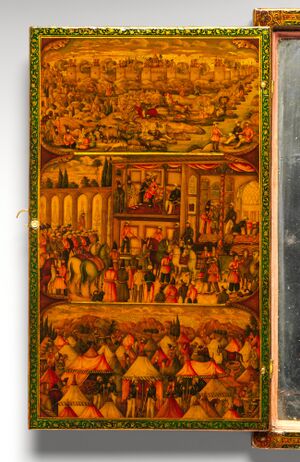
خوفاً من عواقب هزيمة عثمانية ساحقة على يد روسيا، شكلت بريطانيا، فرنسا، ومملكة سردينيا تحالفاً عسكرياً عام 1854، وانضمت إلى الدولة العثمانية ضد روسيا. عُرف النزاع السابق باسم حرب القرم في الدولة العثمانية وغرب أوروپا، ولكنه سُمي في روسيا "بالحرب الشرقية" (بالروسية: Восточная война، "ڤوستوشنايا ڤوينا"). في أبريل 1854، وقّعت النمسا اتفاقية دفاعية مع پروسيا.[27] وهكذا وجدت روسيا نفسها في حرب مع كل القوى العظمى في أوروپا، سواء المتحالفة ضدها عسكرياً أو دبلوماسياً.[28]
عام 1853، كتب ميخائيل پوگودين، أستاذ التاريخ بجامعة موسكو، مذكرة إلى نيقولاي. قرأ نيقولاي بنفسه نص پوگودين، وعلّق مؤيداً: "هذه هي الفكرة الأساسية".[29] وفقاً للمؤرخ أورلاندو فيگس، "لقد لامسَت المذكرة وتراً حساساً لدى نيقولاي، الذي شارك پوگودين شعوره بأن دور روسيا كحامية للأرثوذكس لم يُعترف به أو يُفهم، وأن الغرب عومل روسيا بشكل غير عادل". وكتب پوگودين:[30]
فرنسا تستولي على الجزائر من تركيا، وكل سنة تقريباً تضم إنگلترة إمارة هندية أخرى: لا شيء من هذا يُخل بتوازن القوى؛ لكن عندما تحتل روسيا مولدوڤا وولاخيا، ولو مؤقتاً فقط، فإن ذلك يُخل بتوازن القوى. تحتل فرنسا روما وتُقيم هناك لعدة سنوات خلال فترة السلم: هذا لا شيء؛ لكن روسيا لا تفكر إلا في احتلال القسطنطينية، ويُهدد سلام أوروپا. أعلن الإنگليز الحرب على الصينيين، الذين يبدو أنهم أساءوا إليهم: لا يحق لأحد التدخل؛ لكن روسيا مُلزمة بطلب الإذن من أوروپا إذا تشاجرت مع جارتها. هددت إنگلترة اليونان بدعم ادعاءات كاذبة ليهودي بائس وأحرقت أسطولها: هذا عمل مشروع؛ لكن روسيا تطالب بمعاهدة لحماية ملايين المسيحيين، ويُعتبر ذلك تعزيزاً لموقفها في الشرق على حساب توازن القوى. لا يمكننا أن نتوقع من الغرب سوى الكراهية العمياء والحقد...
— مذكرة ميخائيل پوگودين إلى نيقولاي الأول، 1853[29]
قدمت النمسا للعثمانيين دعماً دبلوماسياً، وظلت پروسيا على الحياد، تاركةً روسيا بلا حلفاء في القارة. نزل الحلفاء الأوروپيون في القرم وحاصروا قاعدة سڤاستوپول البحرية الروسية شديدة التحصين. خسر الروس معارك ألما في سبتمبر 1854[31] ثم في بالاكلاڤا وإنكرمان.[31] بعد حصار سڤاستوپول المطول سقطت القاعدة، كاشفةً عجز روسيا عن الدفاع عن حصنٍ رئيسي على أراضيها. بوفاة نيقولاي الأول، تولى ألكسندر الثاني الحكم. في 15 يناير 1856، أخرج القيصر الجديد روسيا من الحرب بشروط غير مواتية، شملت خسارة أسطول بحريٍّ في البحر الأسود.
بغضه للثورات
كان القيصر نيقولاي الأول يخاف من تسرب أي أفكار تقدمية إلى روسيا، ومن هنا كان تخوفه من الثورة الفرنسية والثورة الپولندية عام 1830- 1831 الهادفة إلى التحرر والاستقلال، وخاصةً أن پولندا كانت وقتذاك جزءاً من الامبراطورية الروسية، فكانت ردة فعل القيصر قوية، حيث عمل على سحقها بقسوة بالغة. ولأنه كان يحاول قمع الحركات الثورية وخنقها في أوروپا انضم عام 1833 إلى تحالف مع ملوك پروسيا والنمسا، وقطع العلاقات مع جمهورية فرنسا عام 1848، وشارك جيشه في هزيمة الثورة في المجر عام 1849 وفي آسيا وجنوب شرقي أوروپا، ووسّع امبراطوريته في الشرق الأقصى ووسط آسيا وقزخستان تحت ذريعة البحث عن أسواق لتصريف الناتج الصناعي، وقد توفى نيقولاي الأول بعد اشتعال حرب القرم بسنتين قبل أن تحسم نتيجتها لمصلحة الدولة العثمانية عام 1856.
وفاته
توفي نيقولاي في 2 مارس 1855، أثناء حرب القرم، في القصر الشتوي في سانت پطرسبورگ. فقد أصيب بالبرد، ورفض أي علاج طبي وتوفي بالتهاب رئوي،[32] بالرغم من وجود شائعات أنه كان يقوم بانتحار سلبي برفضه العلاج.[33] وقد دُفِن في كاتدرائية پتروپاڤلوڤسك في سانت پطرسبورگ. وقد حكم لمدة 30 عاماً، وخلفه ابنه ألكسندر الثاني.
الذكرى
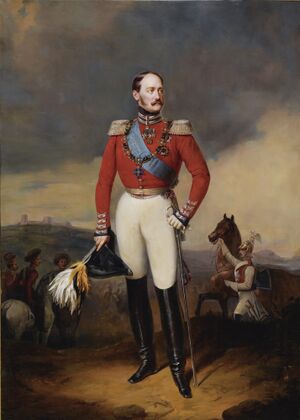
صدرت عدة أحكام دامغة على حكم نيقولاي الأول وإرثه. في أواخر حياته، صرح أحد أكثرِ موظفيهِ تفانياً، ألكسندر نيكيتنكو، قائلاً: "إن العيب الرئيسيَ في عهد نيقولاي باڤلوڤيتش هو أن كل شيء كان خطأً".[34] عام 1891، قام لـِڤ تولستوي بترويج لقب Николай Палкин (نيقولاي العصا) في إشارة إلى الانضباط العسكري المرتبط بالإمبراطور الراحل.[35]
ومع ذلك، تُبذل جهود من حين لآخر لإنعاش سمعة نيقولاي. من ناحية أخرى، تُشير المؤرخة باربرا يلاڤيتش إلى العديد من الإخفاقات، بما في ذلك "الوضع المالي الكارثي لروسيا"، والجيش ضعيف التجهيز، ونظام النقل غير الكافي، والبيروقراطية "التي اتسمت بالرشوة والفساد وانعدام الكفاءة".[36]
تأسست جامعة كييڤ عام 1834 على يد نيقولاي الأول. وفي عام 1854، بلغ عدد طلبة الجامعة في روسيا 3.600 طالب، أي أقل بألف طالب عن عام 1848. كانت الرقابة حاضرة في كل مكان؛ يكتب المؤرخ هيو سيتون-واطسون: "ظلّ الجوّ الفكري خانقاً حتى نهاية عهده".[37]
بصفته رحالة في إسپانيا وإيطاليا وروسيا، كتب الفرنسي ماركيز دي كوستين في كتابه الذي حظي بقراءة واسعة النطاق روسيا في 1839 (الترجمة الإنگليزية: إمبراطورية القيصر: رحلة عبر روسيا الخالدة) أن نيقولاي كان إنساناً طيباً من الداخل، وكان يتصرف كما تصرف فقط لأنه كان يعتقد أنه ملزم بذلك: "إذا لم يكن لدى الإمبراطور المزيد من الرحمة في قلبه مما يظهره في سياساته، فإنني أشفق على روسيا؛ من ناحية أخرى، إذا كانت مشاعره الحقيقية متفوقة حقاً على أفعاله، فإنني أشفق على الإمبراطور".[38]
يظهر نيقولاى في أسطورة حضرية حول سكة حديد سانت پطرسبورگ-موسكو. عندما وُضع مخطط الطريق عام 1842، زُعم أنه طالب باستخدام أقصر طريق، رغم وجود عقبات كبيرة في الطريق. تقول القصة أنه استخدم مسطرة لرسم الخط المستقيم بنفسه. انتشرت هذه القصة الكاذبة في الداخل والخارج كتفسير لسوء حكم روسيا. بحلول ع. 1870، كان الروس يروون رواية مختلفة، مدّعين أن القيصر كان حكيماً في التغلب على المصالح المحلية التي أرادت تحويل مسار السكة الحديدية. ما حدث في الواقع هو أن المهندسين هم من وضعوا الطريق، وأيد نيقولاي نصيحتهم بالبناء في خط مستقيم.[39]
تكريمات
| Styles of نيقولاي الأول من روسيا | |
|---|---|
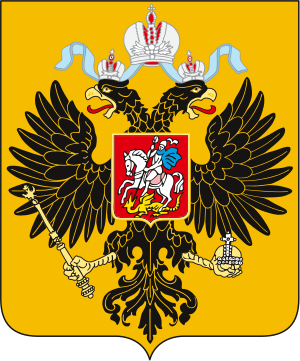 | |
| أسلوب الإشارة | جلالة الإمبراطور |
| أسلوب المخاطبة | جلالة الإمبراطور |
 الإمبراطورية الروسية:[40]
الإمبراطورية الروسية:[40]
- فارس القديس أندرو، 6 يوليو 1797
- فارس القديس ألكسندر نڤسكي، 6 يوليو 1797
 مملكة پروسيا:[41]
مملكة پروسيا:[41]
- فارس النسر الأسود، 31 يناير 1809[42]
- الصليب الأعظم للنسر الأحمر، 31 يناير 1809
 السويد: فارس السرافيم، 4 سبتمبر 1812[43]
السويد: فارس السرافيم، 4 سبتمبر 1812[43] إسپانيا: فارس الوبر الذهبي، 13 أبريل 1817[44]
إسپانيا: فارس الوبر الذهبي، 13 أبريل 1817[44] باڤاريا: فارس القديس هيوبرت، 1823[45]
باڤاريا: فارس القديس هيوبرت، 1823[45] مملكة فرنسا: فارس الروح القدس، 1824[46]
مملكة فرنسا: فارس الروح القدس، 1824[46] الدنمارك: فارس الفيل، 24 يناير 1826[41]
الدنمارك: فارس الفيل، 24 يناير 1826[41] سردينيا: فارس البشارة، 15 أبريل 1826[47]
سردينيا: فارس البشارة، 15 أبريل 1826[47] هولندا: الصليب الأعظم لمرتبة ڤيليام العسكرية، 11 مايو 1826[48]
هولندا: الصليب الأعظم لمرتبة ڤيليام العسكرية، 11 مايو 1826[48] الإمبراطورية النمساوية: الصليب الأعظم للقديس ستيفان، 1826[49]
الإمبراطورية النمساوية: الصليب الأعظم للقديس ستيفان، 1826[49] زاكسه-ڤايمار-آيزناخ: الصليب الأعظم للصقر الأبيض، 3 نوفمبر 1826[50]
زاكسه-ڤايمار-آيزناخ: الصليب الأعظم للصقر الأبيض، 3 نوفمبر 1826[50] ڤورتمبرگ:[51]
ڤورتمبرگ:[51]
- الصليب الأعظم لتاج ڤورتمبرگ، 1826
- وسام الصليب الأعظم لوسام الاستحقاق العسكري، 6 أكتوبر 1826
 الصقليتان:[41]
الصقليتان:[41]
 المملكة المتحدة: فارس الوشاح، 16 مارس 1827[52]
المملكة المتحدة: فارس الوشاح، 16 مارس 1827[52] بادن:[53]
بادن:[53]
- الصليب الأعظم House Order of Fidelity, 1827
- الصليب الأعظم Military Karl-Friedrich Merit Order، 1827
- الصليب الأعظم لأسد زاهرينگر، 1827
 دوقية هسه العظمى: الصليب الأعظم لوسام لودڤيگ، 11 أبريل 1830[54]
دوقية هسه العظمى: الصليب الأعظم لوسام لودڤيگ، 11 أبريل 1830[54] مملكة ساكسونيا: فارس تاج ساكسونيا، 1836[55]
مملكة ساكسونيا: فارس تاج ساكسونيا، 1836[55] دوقيات أسكانيا: الصليب الأعظم لألبرت الدب، 12 يونيو 1837[56]
دوقيات أسكانيا: الصليب الأعظم لألبرت الدب، 12 يونيو 1837[56] دوقية أولدنبورگ الكبرى: الصليب الأعظم لوسام الدوق پيتر فريدريش لودڤيگ، مع التاج الذهبي، 17 يناير 1839[57]
دوقية أولدنبورگ الكبرى: الصليب الأعظم لوسام الدوق پيتر فريدريش لودڤيگ، مع التاج الذهبي، 17 يناير 1839[57] هانوڤر:[58]
هانوڤر:[58]
 ناخبية هسه: الصليب الأعظم للأسد الذهبي، 4 مايو 1844[59]
ناخبية هسه: الصليب الأعظم للأسد الذهبي، 4 مايو 1844[59]

 الدوقيات الإرنستية: الصليب الأعظم لوسام بيت ساكسه-إرنستين، 1847[60]
الدوقيات الإرنستية: الصليب الأعظم لوسام بيت ساكسه-إرنستين، 1847[60] مملكة الپرتغال: الصليب الأعظم لوشاح الأوسمة الثلاثة، 31 مايو 1850[61]
مملكة الپرتغال: الصليب الأعظم لوشاح الأوسمة الثلاثة، 31 مايو 1850[61]
أسلافه
الأنجال
تزوج نيقولاي من شارلوت من پروسيا (1798–1860) والتي سميت بعد ذلك باسم ألكسندرا فيودورڤنا. شارلوت. شارلوت كانت ابنة فريدريك وليام الثالث من پروسيا ولويزه من مكلنبورگ-شترليتس. وكان نيقولاي وشارلوت أبناء عمومة وكان كلاهما أحفاد فريدريك وليام من پروسيا.
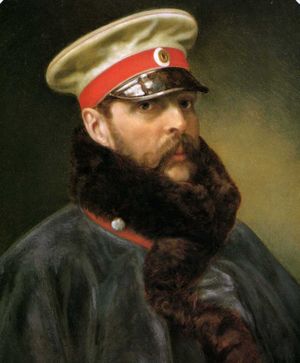
| الاسم | الميلاد | الوفاة | ملاحظات |
|---|---|---|---|
| القيصر ألكسندر الثاني | 17 أبريل 1818 | 13 مارس 1881 | تزوج عام 1841، ماري من هسه والراين; had issue |
| الدوقة العظمى ماريا نيقولايڤنا | 18 أغسطس 1819 | 21 فبراير 1876 | تزوجت عام 1839، ماكسيمليان دى بوهارنيه؛ أنجبا ذرية |
| ابنة وُلدت ميتة | 22 يوليو 1820 | 22 يوليو 1820 | |
| الدوقة العظمى أولگا نيقولايڤنا | 11 سبتمبر 1822 | 30 أكتوبر 1892 | تزوجت عام 1846، كارل من ڤورتمبرگ |
| ابنة وُلدت ميتة | 23 أكتوبر 1823 | 23 أكتوبر 1823 | |
| الدوقة العظمى ألكسندرا نيقولايڤنا | 24 يونيو 1825 | 10 أغسطس 1844 | تزوجت عام 1844، لاندگراڤ فريدريش-ڤلهلم من هسه-كاسل |
| الدوقة العظمى إليزابث نيقولايڤنا | 7 يونيو 1826 | ح. 1829 | |
| الدوق الأعظم قسطنطين نيقولايڤيتش | 9 سبتمبر 1827 | 13 يناير 1892 | تزوج عام 1848، ألكسندرا من ساكسه-ألتنبورگ؛ أنجبا ذرية |
| الدوق الأعظم نيقولاي نيقولايڤيتش | 27 يوليو 1831 | تزوج عام 1856، ألكسندرا من أولدنبورگ؛ أنجبا ذرية | |
| الدوق الأعظم ميخائيل نيقولايڤيتش | 13 أكتوبر 1832 | 18 ديسمبر 1909 | تزوج عام 1857، سسيلي من بادن؛ أنجبا ذرية |
انظر أيضاً
المصادر
- The first draft of this article was taken with little editing from the Library of Congress Federal Research Division's Country Studies series. As their home page at http://lcweb2.loc.gov/frd/cs/cshome.html says, "Information contained in the Country Studies On-Line is not copyrighted and thus is available for free and unrestricted use by researchers. As a courtesy, however, appropriate credit should be given to the series." Please leave this statement intact so that credit can be given.
الهامش
- ^ روسية: Никола́й I Па́влович, النطق Nikoláy I Pávlovich; النطق الروسي: [nʲɪkɐˈlaj ˈpʲervɨj ˈpavləvʲɪtɕ]
- ^ Cowles, Virginia. The Romanovs. Harper & Ross, 1971. ISBN 978-0-06-010908-0 p.164
- ^ Nicholas Riasanovsky, Nicholas I and Official Nationality in Russia, 1825–1855 (1959). p. 3.
- ^ William C. Fuller, Jr., Strategy and Power in Russia 1600–1914 (1998) p. 243.
- ^ Lifgardets 3 Finska Skarpskyttebataljon 1812–1905 ett minnesblad. 1905 Helsinki by Söderström & Co
- ^ Henry Reichman, Railwaymen and Revolution: Russia, 1905 p. 16
- ^ Boltunova, Ekaterina (Spring 2021). "The Last King of Poland: Nicholas I's Warsaw Coronation and Russian-Polish Historical Memory". Kritika: Explorations in Russian and Eurasian History. 22 (2): 229–254. doi:10.1353/kri.2021.0013.
- ^ Hugh Seton-Watson, The Russian Empire: 1801–1917 (1967) p. 277
- ^ Stephen Woodburn, "Reaction Reconsidered: Education and the State in Russia, 1825–1848," Consortium on Revolutionary Europe 1750–1850: Selected Papers (2000), pp. 423–431
- ^ Rebecca Friedman, Masculinity, Autocracy and the Russian University, 1804–1863 (2005)
- ^ Rebecca Friedman, "Masculinity, the Body, and Coming of Age in the Nineteenth-Century Russian Cadet Corps," Journal of the History of Childhood and Youth (2012) 5 #2 pp. 219–238 online
- ^ Etta L. Perkins, "Nicholas I and the Academy of Fine Arts." Russian History 18 #1 (1991): 5–63.
- ^ Orlando Figes, Natasha's Dance: A Cultural History of Russia (2002).
- ^ Helmut de Terra, Humboldt: The Life and Times of Alexander von Humboldt. (1955) pp. 268, 283, 306–07.
- ^ Gartner, Lloyd P. (1978). History of the Jews in Modern Times. Tel-Aviv University: Oxford University Press. p. 164.
- ^ أ ب Gartner, Lloyd P. (1979). History of Jews in Modern Times. Tel-Aviv University: Oxford University Press. p. 168.
- ^ Gartner, Lloyd P. (1978). History of Jews in Modern Times. Tel-Aviv University: Oxford University press. p. 171.
- ^ Gartner, Lloyd P. (1978). History of Jews in Modern Times. Tel-Aviv University: Oxford University Press. p. 170.
- ^ أ ب ت Rendall, Matthew "Restraint or Self-Restraint of Russia: Nicholas I, the Treaty of Unkiar Skelessi, and the Vienna System, 1832–1841" pp. 37–63 from The International History Review, Volume 24, Issue #1, March 2002 p. 38.
- ^ Rendall, Matthew "Restraint or Self-Restraint of Russia: Nicholas I, the Treaty of Unkiar Skelessi, and the Vienna System, 1832–1841" pp. 37–63 from The International History Review, Volume 24, Issue #1, March 2002 p. 47.
- ^ أ ب ت ث Rendall, Matthew "Restraint or Self-Restraint of Russia: Nicholas I, the Treaty of Unkiar Skelessi, and the Vienna System, 1832–1841" pp. 37–63 from The International History Review, Volume 24, Issue #1, March 2002 p. 48.
- ^ Rendall, Matthew "Restraint or Self-Restraint of Russia: Nicholas I, the Treaty of Unkiar Skelessi, and the Vienna System, 1832–1841" pp. 37–63 from The International History Review, Volume 24, Issue #1, March 2002 pp. 48–49.
- ^ Rendall, Matthew "Restraint or Self-Restraint of Russia: Nicholas I, the Treaty of Unkiar Skelessi, and the Vienna System, 1832–1841" pp. 37–63 from The International History Review, Volume 24, Issue #1, March 2002 p. 50.
- ^ Timothy C. Dowling Russia at War: From the Mongol Conquest to Afghanistan, Chechnya, and Beyond p. 728 ABC-CLIO, 2 December 2014 ISBN 1598849484
- ^ Yarshater, Ehsan (2004). Encyclopædia Iranica, Volume 13. Routledge & Kegan Paul. p. 260. ISBN 978-0-93327-395-5.
- ^ Aksan, Virginia. (2014). Ottoman Wars, 1700–1870: An Empire Besieged p. 463. Routledge. ISBN 978-1317884033
- ^ Edward Crankshaw, The Shadow of the Winter Palace, p. 133.
- ^ Edward Crankshaw, The Shadow of the Winter Palace, pp. 135–136
- ^ Edvard Radzinsky, Alexander II: The Last Great Tsar, p. 94.
- ^ أ ب "The Long History of Russian Whataboutism". Slate. March 21, 2014.
- ^ Figes, Orlando (2011). The Crimean War: A History. p. 134. ISBN 9781429997249.
- ^ أ ب W. Bruce Lincoln, The Romanovs, p. 425.
- ^ Peter Oxley, Russia: from Tsars to Commissars, Oxford University Press, (2001), ISBN 0-19-913418-9.
- ^ Yevgeny Anismov, Rulers of Russia, Golden Lion Press, St. Petersburg Russia (2012).
- ^ Crankshaw, Edward (1978). The Shadow of the Winter Palace: the Drift To Revolution 1825–1917. London: Penguin. p. 50. ISBN 9780140046229.
- ^ See Tolstoy's story Николай Палкин (Nicholas the Stick), first published in 1891. - "— А ужъ палками — недѣли не проходило, чтобы не забивали на смерть человѣка или двухъ изъ полка. Нынче ужъ и не знаютъ, что такое палки, а тогда это словечко со рта не сходило. Палки, палки!.. У насъ и солдаты Николая Палкинымъ прозвали. Николай Павлычъ, а они говорятъ Николай Палкинъ. Такъ и пошло ему прозвище."
- ^ Jelavich, Barbara (1974). St. Petersburg and Moscow: Tsarist and Soviet Foreign Policy, 1814–1974. Indiana University Press. p. 119. ISBN 9780253350503.
- ^ Seton-Watson, Hugh (1967). The Russian Empire: 1801–1917. p. 278.
- ^ Kennan, George F. (1971). The Marquis de Custine and his Russia in 1839. Princeton University Press. ISBN 978-0-691-05187-1.
- ^ Haywood, Richard Mowbray (1978). "The 'Ruler Legend': Tsar Nicholas I and the Route of the St. Petersburg-Moscow Railway, 1842–1843". Slavic Review. 37 (4): 640–650. doi:10.2307/2496130. JSTOR 2496130.
- ^ Almanach de la cour: pour l'année ... 1817. l'Académie Imp. des Sciences. 1817. pp. 61, 76.
- ^ أ ب ت Johann Heinrich Friedrich Berlien (1846). Der Elephanten-Orden und seine Ritter: eine historische Abhandlung über die ersten Spuren dieses Ordens und dessen fernere Entwicklung bis zu seiner gegenwärtigen Gestalt, und nächstdem ein Material zur Personalhistorie, nach den Quellen des Königlichen Geheimen-Staatsarchivs und des Königlichen Ordenskapitelsarchivs zu Kopenhagen. Gedruckt in der Berlingschen Officin. pp. 160-161.
- ^ Liste der Ritter des Königlich Preußischen Hohen Ordens vom Schwarzen Adler (1851), "Von Seiner Majestät dem Könige Friedrich Wilhelm III. ernannte Ritter" p. 16
- ^ Per Nordenvall (1998). "Kungl. Maj:ts Orden". Kungliga Serafimerorden: 1748–1998 (in السويدية). Stockholm. ISBN 91-630-6744-7.
{{cite book}}: CS1 maint: location missing publisher (link) - ^ "Caballeros existentes en la insignie Orden del Toison de Oro". Guía de forasteros en Madrid para el año de 1835 (in الإسبانية). En la Imprenta Nacional. 1835. p. 72.
- ^ Bayern (1852). Hof- und Staatshandbuch des Königreichs Bayern: 1852. Landesamt. p. 7.
- ^ Teulet, Alexandre (1863). "Liste chronologique des chevaliers de l'ordre du Saint-Esprit depuis son origine jusqu'à son extinction (1578-1830)" [Chronological List of Knights of the Order of the Holy Spirit from its origin to its extinction (1578-1830)]. Annuaire-bulletin de la Société de l'Histoire de France (in الفرنسية) (2): 122. Retrieved 24 March 2020.
- ^ Luigi Cibrario (1869). Notizia storica del nobilissimo ordine supremo della santissima Annunziata. Sunto degli statuti, catalogo dei cavalieri. Eredi Botta. p. 104.
- ^ "Militaire Willems-Orde: Romanov, Nicolaas I Pavlovitsj" [Military William Order: Romanov, Nicholas I Pavlovich]. Ministerie van Defensie (in الهولندية). 11 May 1826. Retrieved 7 June 2020.
- ^ "A Szent István Rend tagjai" Archived 22 ديسمبر 2010 at the Wayback Machine
- ^ Staatshandbuch für das Großherzogtum Sachsen / Sachsen-Weimar-Eisenach (1840), "Großherzogliche Hausorden" p. 6
- ^ Württemberg (1854). Königlich-Württembergisches Hof- und Staats-Handbuch: 1854. Guttenberg. pp. 32, 58.
- ^ Shaw, Wm. A. (1906) The Knights of England, I, London, p. 53
- ^ Hof- und Staats-Handbuch des Großherzogtum Baden (1853)، "Großherzogliche Orden" pp. 30, 36, 45
- ^ "Großherzogliche Orden und Ehrenzeichen" (in de), Hof- und Staatshandbuch des Großherzogtums Hessen: für das Jahr ... 1854, Darmstadt, 1854, p. 8
- ^ Sachsen (1854). Staatshandbuch für den Freistaat Sachsen: 1854. Heinrich. p. 3.
- ^ Anhalt-Köthen (1851). Staats- und Adreß-Handbuch für die Herzogthümer Anhalt-Dessau und Anhalt-Köthen: 1851. Katz. p. 10.
- ^ Staat Oldenburg (1854). Hof- und Staatshandbuch des Großherzogtums Oldenburg: für ... 1854. Schulze. p. 27.
- ^ Hof- und Staats-Handbuch für das Königreich Hannover. Berenberg. 1853. p. 32, 56.
- ^ Hessen-Kassel (1853). Kurfürstlich Hessisches Hof- und Staatshandbuch: 1853. Waisenhaus. p. 11.
- ^ "Herzogliche Sachsen-Ernestinischer Hausorden" (in de), Adreß-Handbuch des Herzogthums Sachsen-Coburg und Gotha, Coburg, Gotha: Meusel, 1854, p. 29
- ^ Bragança, Jose Vicente de; Estrela, Paulo Jorge (2017). "Troca de Decorações entre os Reis de Portugal e os Imperadores da Rússia" [Exchange of Decorations between the Kings of Portugal and the Emperors of Russia]. Pro Phalaris (in البرتغالية). 16: 9. Retrieved 19 March 2020.
نيقولاي الأول من روسيا فرع أصغر من بيت أولدنبورگ وُلِد: 6 يوليو 1796 توفي: 2 مارس 1855
| ||
| ألقاب ملكية | ||
|---|---|---|
| سبقه ألكسندر الأول |
إمبراطور روسيا 1 ديسمبر 1825 – 2 مارس 1855 |
تبعه ألكسندر الثاني |
| ملك بولندا 1 ديسمبر 1825 – 25 يناير 1831 | ||
| دوقية فنلندا الكبرى 1 ديسبر 1825 – 2 مارس 1855 | ||
- Articles containing روسية-language text
- CS1 maint: location missing publisher
- CS1 السويدية-language sources (sv)
- CS1 الإسبانية-language sources (es)
- CS1 الفرنسية-language sources (fr)
- CS1: Julian–Gregorian uncertainty
- CS1 الهولندية-language sources (nl)
- CS1 البرتغالية-language sources (pt)
- Short description is different from Wikidata
- Pages using Lang-xx templates
- Articles with hatnote templates targeting a nonexistent page
- مناهضة الكاثوليكية في الأرثوذكسية الشرقية
- مناهضة الكاثوليكية في روسيا
- تاريخ روسيا
- أباطرة روس
- ملوك بولنديون
- حكام فنلندا
- أشخاص من ثورات 1848
- أشخاص من حرب القرم
- بيت هولشتاين-گوتورپ-رومانوڤ
- فرسان الوشاح
- فرسان الوبر الذهبي
- مواليد 1796
- وفيات 1855
- ملوك أرثوذكس
- مدفونون في كاتدرائية پطرس وپاڤل، سانت پطرسبورگ
